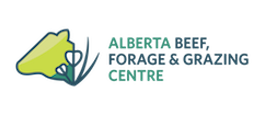About the Alberta Beef Forage and Grazing Centre
The Alberta Forage and Grazing Center was designed in order to strengthen collaboration and coordination in research and extension activities around the province and eventually western Canada in areas related to the beef-forage interface using a systems approach that includes economic analyses.
Purpose
- Provide practical research and extension information to the beef and forage industries.
- Integrating and focusing resources within Alberta Agriculture and Forestry, Agriculture and Agri-Food Canada, Universities, Colleges, and industry.
- Maintaining strong industry partnerships.
- Establishing long term commitment from government and industry in this area.
- Building skill and expertise in the forage/beef interface.
Vision
Mission
Strategic Goals: ? Click to expand
Swath Grazing of the cow herd (through higher yield and quality, increasing available carrying capacity)
Yield: Increase yield at swathing time (September) – Breeding and Management
- evaluate cereal species and lines for forage yield when planted late enough to swath in September.
- select lines with photoperiod insensitivity.
- identify species and lines that use the whole season and deliver a high forage yield in September.
Quality: Improve quality of swathed product to reduce the daily dry matter requirement for winter grazing cows (breeding, management, physiology and nutrition)
- identify optimum harvest time: i.e. stage of grain development; may vary for barley vs. triticale.
- develop (breed) and test (management) barley lines with high digestibility.
- develop triticale with improved cell wall or fiber digestibility.
- develop genetic markers for fiber digestibility of barley and triticale.
Dormant Grazing (management, nutrition and production economics)
- define role (time, species, carrying capacity, cost) of dormant grazing relative to swath grazing.
- define dormant grazing relative to minimum yield, quality and carrying capacity requirements.
- define role and economic value of first cut yield as it relates to dormant grazing.
- compare dormant grazing to swath grazing for cow performance and costs.
Reduce costs by minimizing waste and reducing inputs
- extend information on limit-grazing and watering in winter.
- evaluate soil nutrient requirements for winter grazing animals by creating or developing information on nutrient balance in winter grazing environments.
Strategies:
- investigate the environmental footprint (greenhouse gases (GHG), nutrient cycling, water and air quality) of beef production systems.
- investigate interaction between carrying capacity and nutrient balance
- impact of winter grazing on greenhouse gas emissions.
Slaughter heifers - 6.44:1, barley based finishing diet
Slaughter steers - 5.85:1, barley based finishing diet
Strategies:
- Breed for a feed efficient (i.e. RFI) cow herd using innovative technologies such as genomics and infrared thermography.
- Reduce the maintenance requirement of beef cattle using RFI and other measures of efficiency.
- Quantify the relationships of feed efficiency with fertility, cow lifetime productivity, early life calf survival, performance, carcass and meat quality, and GHG emissions.
- Quantify the relationship between feed efficiency and cow performance under summer and winter grazing conditions.
- Determine the physiological and genetic basis for efficiency.
- Develop quicker, less expensive “on farm” techniques to identify feed efficient beef animals, and fertile females with longevity (e.g., infrared thermography, genetic markers, near infrared spectrometry).
- Determine the economic benefits of advances in genomics and other innovative technologies related to production efficiency of beef cattle.
Strategies:
Investigate the feasibility of transferring winter grazing methods to backgrounding operations (see reduce winter grazing costs by 50%).
- Determine the minimum pasture requirements to provide successful backgrounding programs in terms of production parameters (i.e. cost per day; rate of gain; carrying capacity/ha (pasture days x stocking rate); animal weight; animal gain).
- Determine minimum nutrient requirements for growing beef animals under winter grazing environments.
- Determine daily feed intake of efficient and inefficient stocker cattle on summer pasture.
- Improve digestibility of barley and triticale lines used for silage and winter grazing (using breeding techniques).
- Investigate management methods (species choice, time of grazing) for improving protein, digestibility levels and forage availability in fall and winter grazing operations.
- Evaluate and publish potential of cereal varieties for use on backgrounding rations.
- Determine role of dormant stockpiled grazing relative to swath grazing for backgrounding.
- Develop methods for sorting and identifying young beef animals for potential production efficiency when utilizing forage rations and winter grazing using genomics and other innovative technologies.
- Develop protocols for introducing weaned animals to winter grazing.
- Develop protocols for supplementation during winter feeding and grazing.
Strategies:
- Evaluate species and/or species mixtures for production from August through October.
- Evaluate economic role and capacity of stockpiling perennials for use in backgrounding and cow-calf systems during late summer and fall.
- Define impact of the limiting factor or factors for fall regrowth among the interaction of species x soil moisture x soil nutrients.
- Develop a nutrient balance model for predominantly grass, grass-legume and legume pastures in central Alberta.
- Team approach to forage-beef systems capacity building and training for knowledge workers.
- Attract government and industry support by demonstrating value and return on investment.

